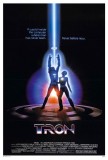By James Reader
The 1980s were an iconic decade. After all, it was the time of big hair and big shoulders, aerobics, Cabbage Patch Kids, The A-Team, and Pac-Man. Oh yes, Pac-Man. You couldn't escape from the constantly chomping computerised character in the early 1980s. Pac-Man was the first international superstar whose only claim to fame was being the star of an arcade game. Computer gaming had finally made its mark.
So what does this have to do with Disney? Well, while start of the decade promised everyone a revolution in entertainment, Disney was struggling. Its animated films were slowly loosing their creative spark and, although successful with the Witch Mountain and Herbie films, their live action releases had slowed to a crawl. Desperate for a hit, Disney jumped on the rapidly expanding video game bandwagon when the opportunity was presented to them by Steven Lisberger, the owner of a small animation company.
Tron is the story of computer programmer Flynn (played by Jeff Bridges). Flynn used to work for Encom, a company which, among other things, manufacturers the world's most popular video arcade games. While Flynn created the games, his work was stolen by Encom executive Dillinger (David Warner). Now finding work at a video game arcade himself, Flynn constantly attempts to break into Encom's files so that he can prove his work was stolen. A finally succeeds with the assistance of his friends and current Encom employees Lora and Alan (Cindy Morgan and Bruce Boxleitner). However, Flynn falls foul of a device Lora is working on to digitize objects and is physically sucked into the computer himself.
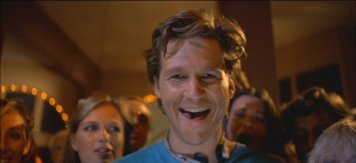
Inside the computer, Flynn finds himself with superpowers. In addition, every "User" in the real world has their computerised counterpoint. Lora's is Yuri, Dillinger's is Sark and Alan's is Tron. Caught up in a battle for freedom against the dictatorial MCP and its computerised army, Flynn battles alongside Yuri and Tron while still looking for proof that Dillinger stole his work.
What sold the film at the time was the visual representation inside the computer world. Although actual computers weren't used as often as you would initially think (with a lot of the effects being achieved with a number of traditional animation methods) nothing of its kind had ever been seen on cinema screens before. Seeing the lightcycle competition on the big screen is something any child of the 1980s will not forget. But ultimately the story fails as the effects overwhelm the film, overwhelming what should be quieter, subtler character moments.
Tron is ultimately a film of its time. Watching it today it fails to impress either visually or narratively. The ideas presented in the film have been expanded in other films and television programs - notably the successful Matrix trilogy.
 |
DVD Details
2.20:1 Anamorphic Widescreen
Dolby Digital 5.1 (English)
Subtitles: English, French, Spanish
Closed Captioned
THX-Certified
Release Date: January 15, 2002
Two single-sided, dual-layered discs (DVD-9)
Suggested Retail Price: $19.99 (Was $29.99)
Black Dual Alpha Keepcase
Out of Print
|
VIDEO and AUDIO
The film is presented in its original aspect ratio of approximately 2.20:1 and has been enhanced for widescreen televisions. Blacks are reproduced exceptionally in both the real world and computer world segments. However the colours in the real world are probably a bit too bright, but film grain is almost nonexistent.
Perhaps due to the extensive processing involved in order to realise the computer world visuals, these sequences do appear to be somewhat grainy in places, something particularly noticeable on the character's faces. The good news is that the computer generated sequences look stunning with outstanding clarity and colours.

Tron is presented exclusively in Dolby Digital 5.1. Whereas, the original DVD release offered 4.0 sound, the film is mixed into full glory, with extremely pleasing results. The film is set inside a video game, and you do feel the interactive and enveloping nature of the material's themes through this sound mix. In its most exciting scenes, the interplay between all of the speakers makes for a unique and very active audio experience. Dialogue does seem a bit low, compared to the volume levels of the sound effects and music. All in all, it's an effective and memorable soundtrack.
EXTRAS
Tron is presented in a 2 disc set - the Movie and a small number of supplements on disc 1, while the majority of the supplements are available on disc 2. Concept wise, this release seems to be a combination of Disney's successful Platinum Edition range and their (then) unreleased Vault Disney range. The set features the extensive galleries and the brief featurettes of the Platinum Editions, but also the continuous lengthy and informative documentary found on the Vault Disney discs. The set is labelled as a "20th Anniversary Collector's Edition".
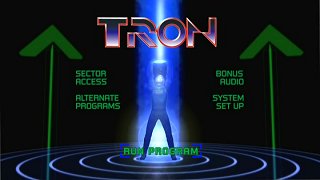 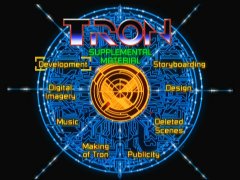
DISC 1
The disc opens with a brief teaser for something called "Tron: Killer App" (0.40) which may be a PC game, or it may be a teaser for the long awaited "Tron 2.0" movie. From the disc's main menu it is also possible to see Sneak Peaks of "Return to Never Land" (2:39) and "Atlantis" (0:49).
The main supplement is the Audio Commentary (95:42) featuring director Steve Lisberger, producer Donald Kushner and visual effects supervisors Harrison Ellenshaw and Richard Taylor. As you may expect given the participants, this commentary is skewed towards the actual filmmaking and technical problems and their solutions rather than entertainment. It is informative (although some of the information is duplicated on the second disc's bonus features), but it would have been interesting to hear from the actors on an alternative track, who basically had to make the film acting and reacting to nothing.
This disc also features a "THX Optimizer" which should enable you to tweak your home theatre equipment to get the best possible presentation of the film.
DISC 2
As is common with Disney's discs with significant extras, this disc is split into a number of themed menus, each menu dealing with a specific period of the film's creation and release. Any supplements presented in widescreen on this disc are letterboxed and not enhanced for widescreen televisions.
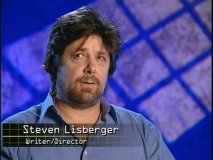 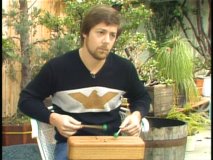 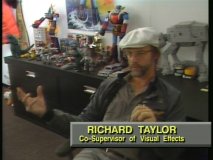
THE MAKING OF TRON
"The Making of Tron": The centrepiece of the second disc gets a menu item all of its own. This is an all-new, full-length documentary running just under one and a half hours (88:17). Created especially for the DVD everything you ever wanted to know about the conception and making of the film is here. Most of the films major creators and actors are interviewed, plus there are contributions from Disney's own Dick Cook and Pixar's John Lasseter. I did notice that the actor David Warner didn't contribute to this documentary, a shame as he contributes so much to the film. But this sad omission doesn't stop the documentary from being thoroughly entertaining and crammed full of information and anecdotes. It ends with brief discussions on the possibility of a sequel film. Chapter stops would have been a nice inclusion for such a long documentary.
The various themed sections are as follows:
DEVELOPMENT
This section looks at the early development of the film; from existing animation that influenced the look of the film to early designs and tests.
"Early Development": This is a short featurette where the origins and inspirations for Tron are discussed (2:39).
"Early Lisberger Studios Animation": This is a short clip (0:42) of a prototype Tron which was created using traditional animation techniques.
"Early Concept Art and Background Concepts": A collection of 30 images. These cover early designs and even proof-of-concept test photos.
"Computers Are People Too": This is a sequence dealing with Tron from a longer television program (4:50). Short and promotional, this is the HBO "First Look Special" of the 1980's.
"Early Video Tests": A brief 2 minute test reel was shot before shooting the film began in earnest. This feature shows a short clip of this test reel (0:42) in widescreen (but no audio).
  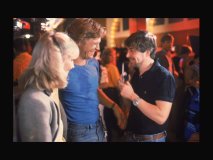
STORYBOARDING
Being as the whole film was planned with storyboards (something of a rarity for a live action film in those days) this gets a section all to itself.
"The Storyboarding Process": A featurette that describes and shows in detail each storyboard image from the final moments of the Lightcycle sequence. This description is intercut with brief moments from the film. (3:54)
"Creation of the Tron Main Title - Moebius' Storyboard": This short snippet shows the opening sequence in storyboard format, with the soundtrack playing in the background (0:18)
"Moebius Misc. Storyboards": This is a gallery of 78 images created by acclaimed European comic book artist Moebius. Some of these images are just beautiful to look at.
"Early Storyboard Artwork": A gallery of 94 images from various scenes in the final film.
"Storyboard to Film Comparison": This lets the user use their angle button to show either the storyboard images, the final film footage or a combination of both for the final moment of the Lightcycle sequence (2:02). This feature also comes with a short filmed introduction (0:52).
DIGITAL IMAGING
Tron was the first motion picture to make extensive use of digital imaging. Each of the items on this menu is taken from footage recorded at the same time as the film was released, so this section offers something over the all-new "Making of" documentary.
"Backlight Animation": This short featurette shows how the various layers were created and what role each one plays in creating the live action computerised imagery. (1:41)
"Digital Imagery in Tron": This featurette visual effects supervisor Richard Taylor discusses the challenges of realising the groundbreaking visuals introduced in the film, including some of the technological advances made as a result of working on Tron (3:46)
"Beyond Tron": This is a short excerpt (4:11) from a much longer television special shown at the same time as the theatrical release. This sequence shows what graphics house MAGI created for the film and features a range of wonderfully crude CGI which wouldn't even make a Gameboy Advance sweat today.
"The Role of Triple I": This is a brief interview snippet (0:36) discussing what graphics house Triple I did for the film.
"Triple I Demo": This is the full demonstration reel that graphics house Triple I put together to show Disney as a "proof of concept" for the Disney studios. It features a wide range of sequences taken from other Triple I projects. (2:17)
  
DESIGN
Just like Disney's animated films, design was very important in creating a believable world for the movie. This section takes us through various designs and tests.
"Introduction to Design": A brief featurette where director Lisberger discusses some of the influences for the design of the movie, and how the sequel may be different. (1:12)
"The Programs": This splits up into a further sub-menu listing most of the characters in the computer world. Flynn, Tron, Yori, Sark, Dumont, generic Video Warriors and Miscellaneous characters each get their own extensive gallery showing early design work and photographs. The Bit also gets a gallery, as does the MCP. In addition the MCP also gets a short video test - "Animation Test - MCP Speaks" (0:33).
"The Vehicles": This splits up into a further sub-menu listing the following vehicles from the film; Lightcycle, Recognizer, Tank, Sark's Carrier and the Solar Sailor. Each of the vehicles has an extensive design gallery covering several pages. In addition the following featurettes are included. The Lightcycle section includes two short films; "Syd Mead Discusses Lightcycle Design" (1:54), which appears to be some archive footage, and "MAGI Animation Tests" (0:18). The Recognizer includes the "Space Paranoids Video Game" sequence in either letterbox (stretched from the full screen original) or full screen (both sequences are 0:18).
"The Electronic World": This is a series of galleries split into the following sections; Dillinger's Office and Flynn's Arcade, The Game Grid, I/O Tower Designs, The Power Cave, Yori's Apartment, The Electronic World and Triple I Models. Each section ranges from 1 to 4 pages of images. There are 75 images in total.
MUSIC
This section doesn't offer much, just a few tracks of unused music. Personally I would have grouped these with the later Deleted Scenes section.
"Lightcycle Scene with Alternate Carlos Music Tracks": In the film the Lightcycle sequence was shown with only dialogue and sound effects. This sequence shows the scene with the original music mixed into the soundtrack (3:18).
"End Credits with Original Carlos Music": In the final film a song replaced the original music for the second half of the end credits. This sequence shows the credits with the full-length original music (5:26)
 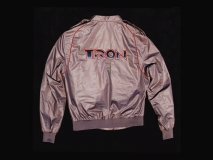 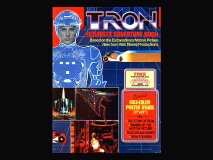
DELETED SCENES
Like most films, sequences were filmed for Tron which were then later edited out. However the number of deleted sequences for Tron is very small; perhaps due to the extensive storyboarding process before the film was made.
"Introduction": The section opens with an introduction from the filmmakers (2:19). This introduction explains why the Tron and Yori 'love scene' was deleted from the movie. It is worth noting that this introduction also shows some of the design and storyboard images from the scene.
Deleted Scenes: There are two deleted scenes - "Tron and Yori's Love Scene" (2:07) and "Tron and Yori's Love Scene #2" (0.56). While the effects were completed for both sequences no audio track exists for the second sequence.
"Alternate Opening Prologue": This section rounds itself off with a different opening to the film (1:33) which gives more background to the film's setting. While this was not included on the original US theatrical release of the film it was included on all international English languages releases and also on subsequent US re-releases.
PUBLICITY
This section shows us not only how the film was marketed but also sold to theatres themselves, as well as offering us a look at some of the Tron video games and other products that were released alongside the movie.
"Trailers": The bulk of this section is made up of the original trailers. 4 theatrical trailers have a combined running time of 6:54 and are presented in a rather washed out full screen ratio. This section also includes the original NATO (National Association of Theatre Owners) promotion that was used to sell the film to theatre owners and is presented in the correct aspect ratio of the movie (5:05), and a short Work In Progress trailer (1:28) that is again presented in washed out full screen.
"Production Photos": This is a gallery of 87 (mostly black and white) photographs from various aspects of the film's production. An emphasis is placed on the filming of the live action sequences set inside the computer.
"Publicity and Merchandising": This is a gallery of images made up of 7 poster concepts, 4 final posters (which I was dismayed to see had more than a passing resemblance to the Star Wars poster), 5 images of advertising artwork, 9 images of merchandising and toys, 5 video game images and, finally, 7 images of clothing made and worn by the film crew while filming.
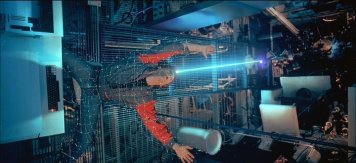
CLOSING THOUGHTS
To fully appreciate the impact and uniqueness of Tron, you really needed see it on the big screen when it was first released. The extensive supplements on this set attempt to explain just how visually and technologically groundbreaking this film was, but nothing can describe experiencing this film for the first time in the early 1980s.
It's doubtful that the film will have much impact on first time viewers today who are used to the latest console games or the polished CGI in Pixar's films. But for anyone who remembers Tron with affection or has an interest in the history of CGI, or even non-traditional uses for animation, this feature packed set is a must-buy. Although it's not an animated classic, Tron gets one of the best 2 disc sets ever to come out of Disney.
More on the DVD / Buy from Amazon.com
 |
